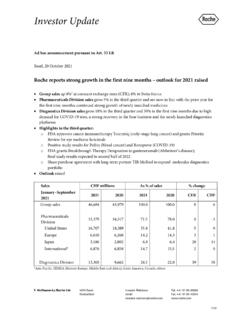Transcription of In India, the adoption of Industry 4.0 is at a nascent ...
1 Table of Contents 3 What is Industry .. 4 From to the rise of the connected ecosystem ..4 Convergence of technology levers .. 5 The connected factory - powering digital manufacturing ..7 India getting ready for Industry .. 8 Current status of Industry in India .. 8 Collaborative transformation .. 11 Role of the government as facilitator .. 11 Role of the India Inc. as architect .. 12 Opportunities and Risks to consider in adoption .. 13Re-engineering the talent pool for Industry .. 14 Leadership India needs digital leaders .. 14 Building the next-gen workforce .. 14 Joint action needed to up-skill India .. 16 Way forward .. 19 Acknowledgement .. 20 About AIMA .. 21 About KPMG in India.
2 22 Preface In India, the adoption of Industry is at a nascent stage. Widespread implementation still looks to be some years away due to challenges such as the need for high investment outlay, inadequate knowhow, lack of infrastructure and lack of adequate cybersecurity norms. However, with benefits such as cost reduction, higher efficiencies, safer factories and faster speed to market, Industry can provide the country s manufacturing sector the much-needed platform to stay competitive in the global market. Furthermore, with the government s focus on manufacturing through programmes such as Make in India and policies such as the National Policy for Advanced Manufacturing , Industry could play a key role in boosting the manufacturing sector s share in the country s GDP to 25 per cent by 2022 from the current 17 per cent.
3 That said, for the true value of Industry to be unleashed, it has to transcend large manufacturing companies and become accessible to the 50 million plus enterprises that make up India s MSME sector, accounting for about 45 per cent of total manufacturing output and 40 per cent of total export. This is where the Indian government assumes the role of a critical stakeholder. Putting the Indian MSME sector at the forefront of the fourth Industrial revolution will need significant push in terms of funds, infrastructure, technical knowhow and exposure areas where the government s intervention can make a significant impact and make the benefits of Industry accessible to the bottom of the pyramid.
4 Furthermore, the government s role in India s Industry story goes much beyond just enabling the MSME segment. With a large manufacturing base, a significant IT Industry and a burgeoning consumer base, India is in a unique position to fully harness the potential of Industry , provided there is strong governing force orchestrating the ecosystem and bringing these individual components together. Given the strong role of advanced technology in Industry , there is also a need to demystify the core skill requirements of Industry through education and enablement. Best practices from nations that have succeeded with Industry , such as Germany, show that the government has a strong role to play here too by mandating relevant curriculum in educational institutes as well as in the vocational training infrastructure.
5 Partnering with the Industry , the government can use its vast research infrastructure to encourage innovation and learning around Industry This report looks into the state of Industry adoption in India. Starting with understanding what Industry entails, the report explores the various technology levers enabling the phenomenon, compares India s Industry landscape with that of global peers, assesses benefits and challenges for India s manufacturers, and analyses the key enablers that are required to take the Industry landscape in the country to the level of maturity it has the potential to attain. The report looks at building a supporting ecosystem combining forces from the government, enterprises and academia, highlighting the role that each of the stakeholders can play to make Indian manufacturing flourish on the back of advanced technology and next-generation leadership and talent.
6 The report is built on key themes identified and deliberated on jointly between the All India Management Association (AIMA) and KPMG in India. Along with data sourced through desk research, it also includes input and opinion from senior Industry leaders and partners. 3 What is Industry After going through three industrial revolutions that brought about significant technological developments over a period of more than two centuries, the world is currently witnessing the fourth Industrial revolution, which is taking technology adoption by the world s factories to a whole new level. This fourth industrial revolution, or Industry ( ), is bringing together the different silos in a production system via a network, allowing real-time data sharing and facilitating machine-to-machine and human-to-machine interactions of unprecedented speed and scale.
7 This is giving rise to seamlessly integrated value chains with inter-connected cyber and physical systems, enabling decentralised decision-making and unprecedented levels of automation. The digitalisation of the entire manufacturing value chain starting from the procurement of raw materials and extending right up to customer service using mobile devices, communication networks, sensors and actuators is completely transforming how the world s factories operate. Widespread adoption of is likely to benefit manufacturers in several ways: Cost reduction and efficiency: Cyber-physical systems can monitor the factory processes and make decentralised decisions, enabling faster processing.
8 For instance, a connected factory is capable of taking automated self-correction measures in the instance of errors. Technologies such as 3D printing and laser technology allow better utilisation of resources such as the shop floor, thereby adding to the operational efficiencies. This leads to cost savings, better productivity and faster time to market. Value add: Digital manufacturing technologies, such as 3D printing, laser cutting, CNC-milling and robotic assembly, allow manufacturing of products in small batches, thereby allowing for better customisation, quality and value add. Health and safety of factory workers: By eliminating the need for human presence and intervention in certain high-risk tasks and environments, can help manufacturers avoid exposing workers to health hazards and reduce fatalities on the factory floor.
9 From to the rise of the connected ecosystem After seeing constant progress on the back of mechanisation, electrification and the advent of the assembly line over two centuries, the global manufacturing Industry adopted information technology in the 1960s, when computers came into the forefront of development, simplifying human effort. From then to now, both operational technology and information technology have come a long way, unleashing a vast plethora of possibilities on the factory floor through 4 Figure 1: Evolution of Industry The transformational nature of the fourth Industrial Revolution particularly lies in its ability to digitally integrate isolated systems using various synergistic technology levers, unleashing unprecedented levels of value.
10 Convergence of technology levers brings together technology forces such as Internet of Things (IoT), cloud computing, big data analytics, additive manufacturing, Augmented Reality (AR), robotics, cyber security and Machine-to-Machine (M2M) communication. While some of these digital technologies are already in use in industrial applications, some others are still not ready for application at scale. Manufacturers need to carefully pick the right mix of technologies that would maximize returns on investment. Information technology led automation as computers were developed to simplify various tasks Mechanisation driven by steam engines and water 1st industrial revolution (mid- 1780s) Mechanisation 2nd industrial revolution (mid-1870s) Electrification 3rd industrial revolution (mid-1960s) Automation 4th industrial revolution (2011-?)





